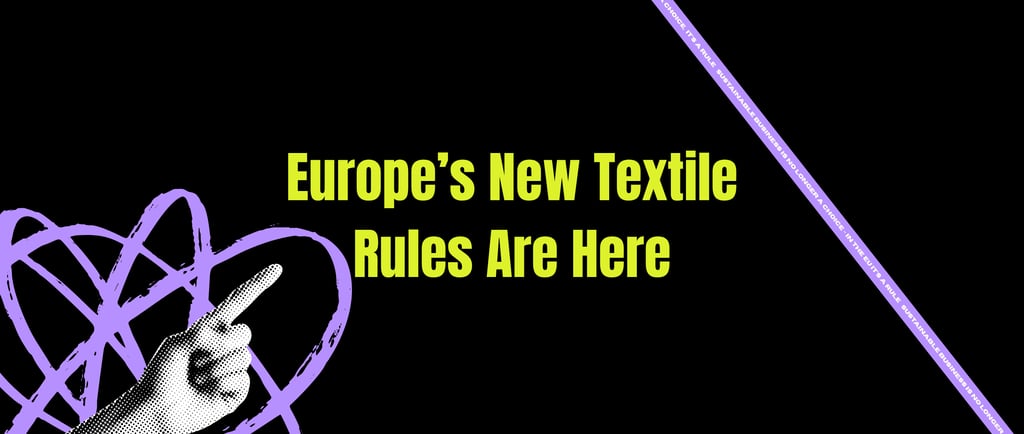EU Textile Repairability Rules: What You Need to Know
Learn how Europe’s new rules on clothing repairability, design, and waste affect your fashion business, and how to stay compliant and competitive.
10/9/20254 min read


Europe’s New Textile Rules Are Here
Change is no longer on the horizon. It’s here.
Since 2024, the European Union has started enforcing a series of rules that completely reshape how clothing and textile businesses operate, from how products are designed and sold to how they’re repaired, reused, or recycled.
For small and medium-sized fashion and textile brands, this isn’t just a compliance story. It’s a chance to build products that last, communicate real transparency, and strengthen customer loyalty. The challenge is knowing what’s required and how to prepare without getting lost in legal talk.
We’ve translated the official EU legislation into plain language so you can plan your next steps more confidently.
The Ecodesign for Sustainable Products Regulation (EU) 2024/1781
The Ecodesign for Sustainable Products Regulation, or ESPR, is the EU’s master rule for how physical goods, including clothing and textiles, must be made and marketed in the coming years.
Its core idea is: every product should be durable, repairable, and traceable.
Simple, right? Well, we'll see...
Under ESPR, Digital Product Passports (DPPs) will become mandatory for textiles. These passports will hold detailed information about the product’s materials, repair instructions, and recyclability. Think of them as a digital ID for each garment, giving manufacturers, retailers, and even consumers a way to access clear data about what a product is made of and how it can be repaired or recycled.
This isn’t a distant goal. Work on the first textile-specific requirements is already underway under the Ecodesign Working Plan, which prioritises apparel and footwear. The European Commission aims to phase these in over the coming years, starting with design requirements that target product durability, reusability, and the prevention of wasteful practices.
One headline rule stands out:
From 2026, companies will be banned from destroying unsold clothes and shoes. This directly addresses overproduction, one of the fashion industry’s biggest issues, and will push brands to rethink their stock management, resale, and donation strategies. Although SME's are exempt, but it is necessary to know this to make better decisions.
For brands like yours, the best preparation now is to start mapping your product data. Understand what materials go into your products, where they come from, and how they could be repaired or recycled. Even if digital passports aren’t mandatory for your category yet, this work will make compliance much smoother and strengthen your sustainability story.
The Right to Repair Directive
In early 2024, the EU introduced the Right to Repair Directive, designed to make repairs accessible, affordable, and standardised across the internal market. While it covers multiple product types, it aligns strongly with the textile sector’s repairability goals. Although there are no legal acts laying down repairability requirements for textiles yet, but they are coming, and you should start preparing ahead.
The Directive gives consumers a stronger legal right to request repairs rather than replacements. Manufacturers must ensure repair services and spare parts are available for a “reasonable price and time frame.” They’ll also be required to inform consumers about repair options clearly, both at the point of sale and after purchase.
A European repair platform will also launch by 2027, connecting consumers with authorised repair providers and making it easier to find reliable services.
For you, this rule changes how after-sales services are managed. Offering repair or alteration services directly, or partnering with local tailors and repair professionals, can turn compliance into a customer loyalty tool. Repair isn’t just an obligation, it’s a way to extend product life and maintain brand value.
The Revised Waste Framework Directive (EU) 2025/1892
Textiles are now officially part of the EU’s Extended Producer Responsibility (EPR) system.
This means that from 2027, all textile producers, including clothing brands, must financially contribute to the collection, reuse, and recycling of textile waste. Member States are required to set up EPR schemes, and producers must join and fund them.
The goal is to shift waste management costs away from municipalities and onto producers, applying the “polluter pays” principle in practical terms.
For businesses, this means new financial and reporting obligations. But it also opens doors for collaboration with recyclers, repair networks, and reuse initiatives that can offset some of these costs through better product recovery.
Brands will also have to provide consumer information on how to reuse or repair products, which ties back neatly to the Ecodesign Regulation’s durability and repairability focus.
What This Means in Practice for You
These laws aren’t abstract, they’ll reshape how every piece of clothing is designed, tracked, and handled after sale. For small and medium-sized brands, this can feel heavy. But in truth, these changes level the playing field. Large corporations can’t rely on scale to bypass environmental responsibility anymore.
So what you can do now:
Start collecting your product data now. Even simple spreadsheets tracking materials, suppliers, and repair components will help when Digital Product Passports become mandatory.
Explore partnerships with repair professionals. Integrate repair vouchers or “preferred partner” repair options in your e-commerce or packaging.
Rethink unsold inventory strategies. Plan for resale, rental, or donation channels before 2027 to stay compliant and reduce waste.
Stay connected with your national EPR discussions. Each EU country will design its own textile responsibility scheme. Joining early lets you influence cost structures and reporting formats.
Communicate clearly with customers. Transparency about your repair and reuse approach builds trust and fits perfectly with the EU’s consumer protection push.
A Shift from Compliance to Competitiveness
The textile and clothing rules aren’t just about penalties or paperwork. They represent a broader shift toward value through responsibility. A well-documented, repairable product has a longer life, higher resale value, and a more credible sustainability narrative.
We’ve seen brands turn these new obligations into clear advantages, designing modular garments, running in-house repair workshops, or building digital product information pages that double as marketing tools.
When you understand the rules, they stop being a burden. They become a blueprint for smarter design and stronger customer connection.
Looking Ahead
Over the next few years, expect additional technical standards for textiles to roll out under the Ecodesign umbrella, covering durability testing, recyclability benchmarks, and material traceability. The European Commission is already working on these through the Textiles Transition Pathway.
By 2030, most clothing sold in the EU will need to meet minimum sustainability and repairability requirements. The businesses that prepare now will move faster when these rules become enforceable.
Next Step of Fashion role is to make this transition smoother. We help fashion brands translate regulation into strategy, mapping supply chains, building circular business models, and designing processes that meet EU standards without losing agility.
The rules are here to stay. But so are the opportunities they create.
